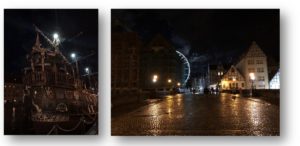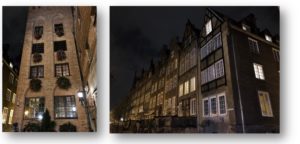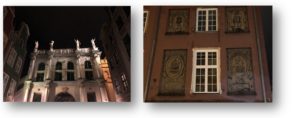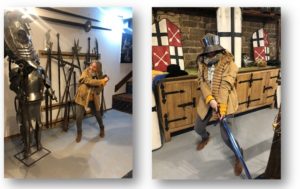
The night after our networking with professionals from Poland, when I arrived at the hotel I decided to put on something extra warm and go for a walk to get to know Gdansk. At the reception of the Hilton hotel in Gdansk, they kindly told me which direction I should take to go to the old city center. It was a rainy and autumnal night where the arctic cold that usually has in its snowy winter was already beginning to be perceived.
I started walking and it was worth everything that I found in my path, from a Pirate Galleon from which Captain Sparrow seemed to appear to a Ferris wheel, not as big as the one in London; but enough to make the visit fun for the little ones.
I went deeper into the alleys of Gdansk and was surprised by the architectural beauty of the Gothic buildings painted in different bright colors and with a characteristic shape of this city, maintaining a similarity with each other that evoked me to a fairytale city.


How wonderful that the citizens of Gdansk took the initiative to rebuild the city as it was originally, since unfortunately and due to the 2nd World War the city was extensively destroyed.

Thanks to the river that runs through it, it reminds me a bit of Amsterdam, but with a special charm, with large, well-constructed buildings, wide, cobbled, clean and well-kept avenues. And also its narrow streets where you can find highly recommended bars and restaurants that delight the most demanding palates.
 Our 2nd day of visiting the Pomorkie area in northern Poland, a tour awaited us to see the most important castles in the region.
Our 2nd day of visiting the Pomorkie area in northern Poland, a tour awaited us to see the most important castles in the region.

And how could it be otherwise, we started with the largest castle in the world, "the Malbork Castle" on the banks of the Vistula river. This Castle was almost completely destroyed in the bombings that Poland suffered in World War II and coincidentally we were guided by a wonderful guide, the daughter of one of the people who collaborated in its reconstruction, so I understand the enthusiasm with which she told us the whole story. of the castle of the Teutonic order.

In the castle you can make the visit with headphones or with a private guide, I recommend the private guide because the visit is always more active, having the opportunity to ask if your curiosity is avid. From 3 hours to 8 hours you can stay visiting the different rooms, towers, kitchens, halls, chapel, etc. What do you find in your path?

During the visit we found something very curious about holes in the ground with some covers that connected to the bottom of the building since you don't know what they were used for……. Well, to heat the floor, it was and is so cold that they have underfloor heating, curious truth!!!.

Then we went through various rooms with frescoes painted on the walls and ceilings that reveal the detail with which buildings were decorated at that time. We entered a room prior to the entrance of a chapel where they showed us how the teachers and priests had to purify themselves before entering the sacred area, much like what happens in the Islamic world today.

To end our visit, we could not miss a visit to the souvenir shop, where a child who loves armor would go crazy.
We traveled another 100 km and arrived at the Gniew castle, a castle that was a convent, jail, arsenal and now it is converted into a multipurpose castle, where you can get married or celebrate any corporate event or incentive.

Upon arrival, we were greeted by characters dressed in period costumes, introducing us to activities typical of the period, such as cannon firing, fencing matches, and knights' jousting.
Mounted on their steeds they showed us what the jousts of the time were like while we drank a hot wine that was appreciated given the cold we had for the time of year, late October.

To end our visit, I took the opportunity to pray a little and ride a horse, one of my passions, thanks to the fact that my request was granted….. Anything you can imagine is possible with Viajes Singulares.

In Peplin, we stopped to see a very unique museum dedicated to the Catholic religion and to Saint John Paul II, which preserves one of the oldest and best preserved Bibles of Christianity. Where we can also find authentic jewels hidden from the Nazis during the 2 great war, which were hidden in Canada, under churches, in remote towns, etc. Every action was important to hide them and prevent these magnificent treasures of the Polish churches from reaching the hands of the Nazis.

Also in Pelpin, we enter the cathedral, with its imposing windows, large windows, its precious altar, its very high ceilings (25 meters) that are studied by architecture schools, with several organs where festivals of sacred music are organized, famous for the their magnificence.

Our last singular experience of the day was to feel like a XNUMXth century clerk, we were shown and given a taste of the authentic way of writing of the ancient copyists who lived in the monasteries. A very interesting experience that I would have liked to continue, but all good things have to end at some point, so it was time to retire and return to the hotel, to catch the plane early the next morning.

I hope to be able to return…..because I had many things to visit in the inkwellWithout a doubt, northern Poland is very worthwhile and we will certainly return.

